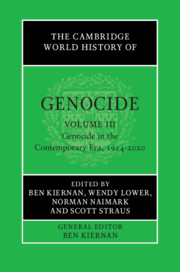Book contents
- The Cambridge World History of Genocide
- The Cambridge World History of Genocide
- The Cambridge World History of Genocide
- Copyright page
- Contents
- Figures
- Tables
- Maps
- Contributors to Volume III
- Introduction to Volume III
- Part I Racism, Total War, Imperial Collapse and Revolution
- Part II World War Two
- Part III The Nation-State System during the Cold War
- 17 Genocide in Latin America, 1950–2000
- 18 China under Mao, 1949–1976
- 19 Half a Century of Genocide and Extermination
- 20 Secession and Genocide in the Republic of Biafra, 1966–1970
- 21 Bangladesh, 1971
- 22 The Genocides in Cambodia, 1975–1979
- 23 The Guatemalan Genocide
- 24 Mass Violence and the Kurds
- 25 Vulnerable Peoples in the Contemporary Era
- Part IV Globalisation and Genocide since the Cold War
- Index
18 - China under Mao, 1949–1976
from Part III - The Nation-State System during the Cold War
Published online by Cambridge University Press: 23 June 2023
- The Cambridge World History of Genocide
- The Cambridge World History of Genocide
- The Cambridge World History of Genocide
- Copyright page
- Contents
- Figures
- Tables
- Maps
- Contributors to Volume III
- Introduction to Volume III
- Part I Racism, Total War, Imperial Collapse and Revolution
- Part II World War Two
- Part III The Nation-State System during the Cold War
- 17 Genocide in Latin America, 1950–2000
- 18 China under Mao, 1949–1976
- 19 Half a Century of Genocide and Extermination
- 20 Secession and Genocide in the Republic of Biafra, 1966–1970
- 21 Bangladesh, 1971
- 22 The Genocides in Cambodia, 1975–1979
- 23 The Guatemalan Genocide
- 24 Mass Violence and the Kurds
- 25 Vulnerable Peoples in the Contemporary Era
- Part IV Globalisation and Genocide since the Cold War
- Index
Summary
In 1949 the red flag was raised over the Forbidden City in Beijing, as Mao Zedong proclaimed the establishment of the People’s Republic of China. How should we characterise the mass killings of ordinary people during the following decades? This chapter will focus on how the regime treated the majority of the population it classified, however arbitrarily, as ‘Han Chinese’. A separate discussion would be necessary to examine what happened in the border areas inhabited by what were called ‘minority nationalities’, from Tibet and the Muslim belt running through Xinjiang, Qinghai, Ningxia and Gansu to Inner Mongolia. Whether or not these killings, intentional or otherwise, should be characterised as genocide will depend on the definition one adopts. As Norman Naimark has pointed out, the Convention on the Prevention and Punishment of Genocide, the foundational legal document adopted by the United Nations in 1948, excluded crimes of humanity against social and political groups from its definition, largely as the result of sustained opposition from the Soviet and other delegates who worried that the repression of their own people at home might be considered genocidal. As a result, few scholars have used the term to qualify crimes against identifiable groups of people seen to belong to the same ‘national’ group as the perpetrators, whether ‘kulaks’ (farmers classified as ‘rich peasants’) or the nobility in the Soviet Union or those defined by the Nazis as ‘homosexuals’ or ‘handicapped’.1
- Type
- Chapter
- Information
- The Cambridge World History of Genocide , pp. 429 - 449Publisher: Cambridge University PressPrint publication year: 2023



